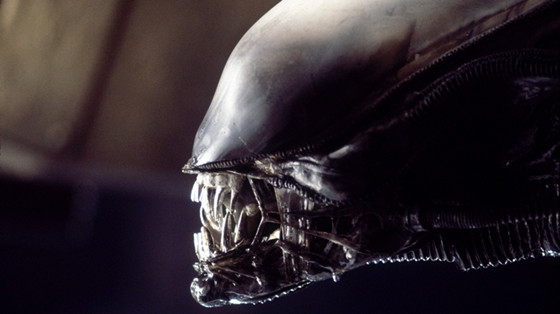
During an interview for the release of Alien Isolation, Yaphet Kotto, who played the role of Chief Engineer Parker in the original Alien, stated, “It’s an original. It’s like Frankenstein or Dracula or Wolfman. Nothing like it seen before or after”. Nearly 40 years later and the Alien, or Xenomorph (meaning strange form), has become one of the most iconic and memorable movie monsters in cinema history.
Originally released in 1979, two years after Star Wars inspired generations with its epic and creative depictions of life in space, Alien brings these aspirations crashing back down. Scott has sucked all the wonder out of space travel. Planets are inhospitable and baron. Travellers have become glorified truckers. The ships, clearly once majestic feats of engineering are now claustrophobic and old. And this is all before the arrival of an intergalactic killing machine. This is a film that does not want you to go into space.
Since then, the original classic has been followed up with three sequels, one brilliant (Aliens), one mediocre (Alien 3) and one bad (Alien Resurrection) as well as two Predator crossovers, several video games and comics and most recently, an origin story (Prometheus) and an upcoming prequel (Alien Covenant), ensuring that the series will carry on for decades to come.
Credit for the original creature can go to numerous people including screenwriters Dan O’Bannon and Ronald Shusett and special effects artist Carlo Rambaldi. However, most of the credit goes to conceptual artist H.R. Giger. Inspired by Necronomicon, a collection of his work, the Swiss surrealist was hired by Ridley Scott as a concept artist and his drawings would be used as inspiration in creating what would become the Alien.
Giger’s work can best be described as surreal, religious, macabre, biomechanical and even sexual. In these drawings, Giger has mixed aspects of the organic with the non-organic to create something truly horrifying. Giger’s work is not only drawn from our worst nightmares, it has the potential to enter the realm of reality.
Movie monsters are steadily making a comeback. The Xenomorph will be seen again soon in the upcoming Alien Covenant. A new Predator film is being made by the creature’s first onscreen victim Shane Black. Both Godzilla and King Kong are returning to the screen and Universal Studios is producing a new series of monster films, resurrecting the classics. So what is it that makes the Alien/Xenomorph the most memorable and perfect cinema monster when there are so many?
10. Cosmic Horror
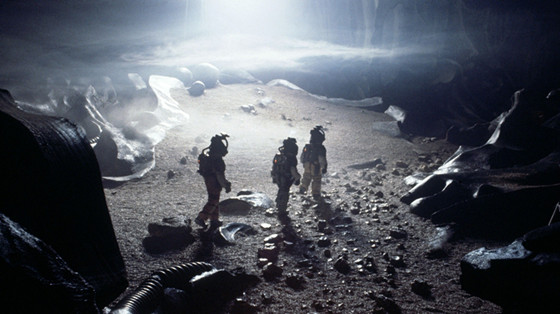
Sadly, there has been a limited number of film adaptations of the work of H.P. Lovecraft. The Rhode Island author may have failed to find a strong readership during his brief lifetime, but since his death in 1937, Lovecraft and his work have found a loyal fellowship with much attention paid to the genre that he worked within: Cosmic horror, also now known as Lovecraftian Horror.
Cosmic Horror has been assigned numerous definitions over the years but some of its key components include: no divine presence, the universe is indifferent to mankind and humanity is insignificant. Lovecraftian tales follow characters that encounter situations, usually extra terrestrial or supernatural, that confronts their personal beliefs over mankind’s presence within the universe. Essentially, Cosmic Horror tackles spirituality and nihilism rather than gore and horror to terrify its audience.
The Alien’s very existence is obscure, especially in the first film. The planet that the crew of the Nostromo is forced to land on is shrouded in mystery. They are ordered to investigate the origins of an unknown distress call. Immediately, it becomes clear that this is not the home planet of the Xenomorph, seen when Dallas, Kane and Lambert enter the ruins of the crashed spacecraft to reveal the Space Jockey.
Before Prometheus revealed their back story, Space Jockeys were one of cinema’s greatest mysteries. Yet this only added to the film’s horror. Their immense size, almost twice as big as a man, gives them a almost God-like presence. Yet, the once majestic being leaves nothing but a rotten corpse. “God is Dead!” as cried Nietzsche, dead from significant trauma to the chest, an ominous warning of what is to come.
The remains of the ship and its dead inhabitants are not provided to give answers, rather it produces nothing but dread. If the Xenomorphs can wipe out a physically and technologically superior species like the Space Jockeys, then humanity is an easy target and that is where Alien’s superiority emerges.
A sense of hopelessness quickly emerges, one consistent with Lovecrafts style. The opening scene depicts the Nostromo slowly drifting through space. Its eight-crew members all alone. What’s more is the absence of an obvious hero. No one stands out as a saviour, especially after the death of Dallas. His death reinforces the hopelessness of the situation.
Not only do we no longer have a possible hero, the survivors learn that one of their numbers, Ash, is a robot designed by the company to protect the specimen. Destroyed in a scuffle, Ash (or what’s left of him) comes clean about his loyalties, “Perfect organism. Its structural perfection is matched only by its hostility. I admire its purity.
A survivor…unclouded by conscience, remorse or delusions of morality…I can’t lie to you about your chances but you have my sympathies”. This statement answers why there is no hero; because there is no villain either. At its core, the Xenomorph is just another survivor, willing to do whatever it takes to live. Just like Ripley.
9. Born through death
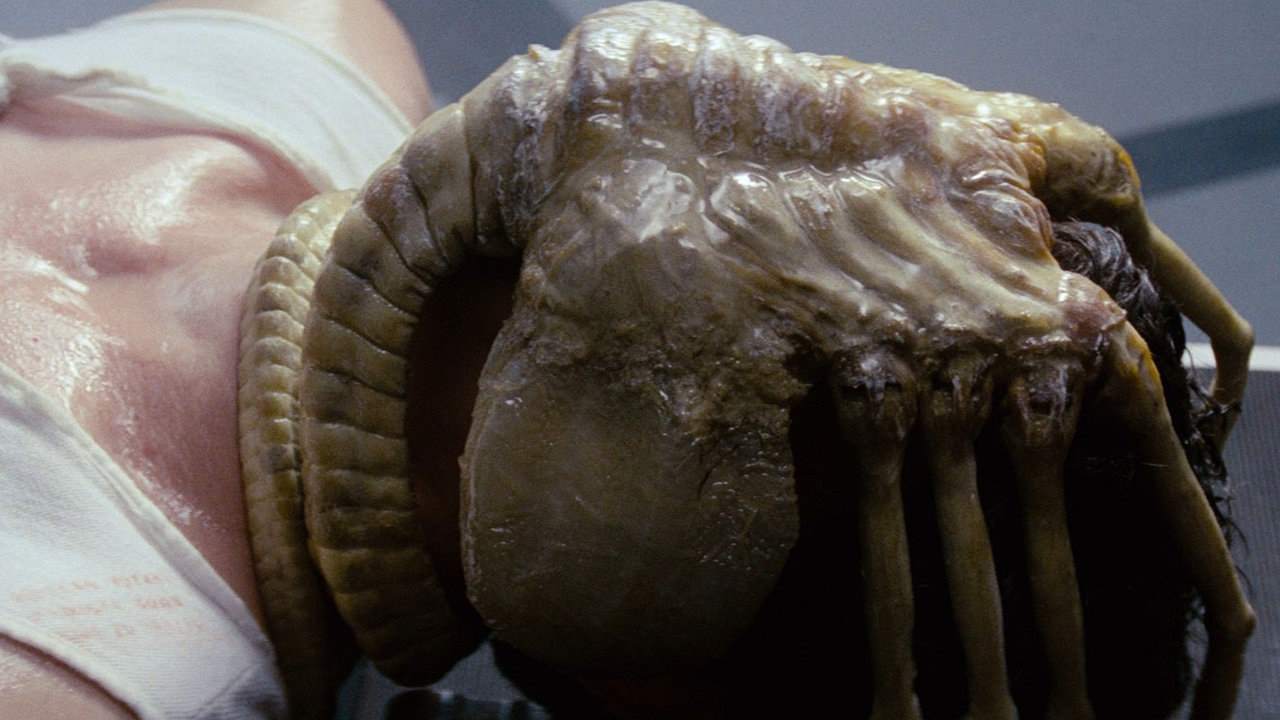
The birth of the Xenomorph baby remains one of the most terrifying moments in cinema history. From the opening scene, tension is being built. The isolation of deep space well established before the distress call is picked up. Ridley Scott ups the ante at every moment.
The revelation that the distress call was a warning, the presence of the Space Jockey and the eggs, the facehugger’s attack, Ripley’s refusal to let the crew back in and the acid blood scare, all slowly build up a sense of dread, only for the facehugger to suddenly die living the once comatose Kane perfectly healthy, even joining the rest of the crew for a meal before being frozen.
The Xenomorph’s birth fits in perfectly with another sub-genre of horror: body horror. Defined as horror from the destruction or deterioration of the human body. Violence and death is an important part of horror, but Body Horror includes various aspects including decay, mutilation and mutation. The Xenomorph acts more like a parasite, incubated within a human hosts body, safe from the outside world before violently tearing its way through the chest cavity, leaving the host in great pain before death.
Just like the works of John Carpenter (The Thing) and David Cronenberg (The Fly, Videodrome), Ridley Scott’s use of body horror is more than just blood and gore. Rather, it depicts the very real horror of our body turning against us.
The human body may not always be able to fight off illness and disease but there is something truly insidious about how the body not only fails to fight off the Xenomorph embryo, but it actually supports it. The body turns against itself and gives life to the creature that will ultimately destroy it.
This theme is further explored in Prometheus with Shaw’s pregnancy with the first Facehugger, a horrifying discovery, especially since her own infertility is a source of great torment for her. Jean Pierre Jeunet took the concept too far by introducing the failed Ripley/Alien clones in Alien Resurrection, but Scott’s examination of implantation as a perverse form of pregnancy adds another layer of horror to already horrific creature.
8. Beauty and the Beast
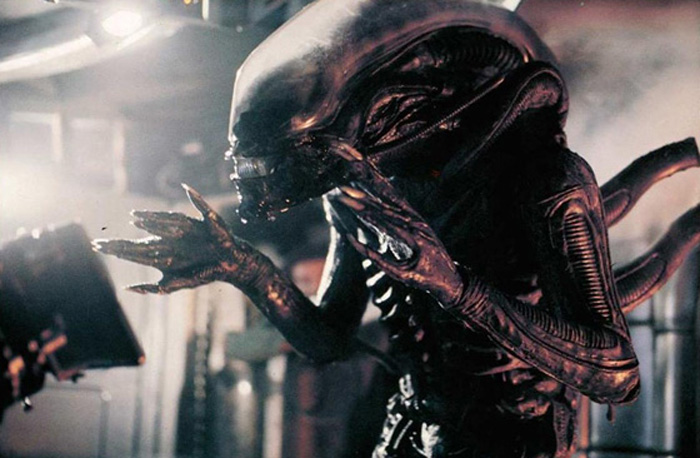
H.R. Giger once said in an interview that, despite being a grotesque and horrific creation, he wanted the Alien to be a beautiful creation, “I always wanted my alien to be a very beautiful thing, something aesthetic. A monster isn’t just something disgusting; it can have a kind of beauty”. Originally, writers O’Bannon and Shusett envisioned a Lovecraftian inspired creature with multiple tentacles. However, the creative team concluded that Giger’s design was superior.
While the film shows very little of the Alien for both artistic reasons (ambiguous horror) as well as practical reasons (limitations of effects), the images we see allow the Alien to linger on screen for brief periods. After brutally killing Parker in the finale of Alien, the Xenomorph moves onto Lambert. Yet, the Alien does not advance upon Lambert like an animal stalking its prey. Rather it almost levitates towards her, its arms gliding slowly through the air. While this is unsettling, it also displays the beauty of the creature.
Despite being an unstoppable killing machine, you cannot take your eyes off the Xenomorph. Various characters throughout the series, including Ash in Alien and Bishop in Alien 3, have gone into great detail about the physical aspects of the creature, far beyond any monetary or scientific value.
Alien Resurrection even made a tongue in check reference to this behaviour, with their scientists behaving in an almost sexualised way with the Aliens, including Dr Gediman (Brad Douriff) who mirrors one of the Aliens through safety glass. Part teasing, part examining and even part flirting.
Beauty is generally in the eye of the beholder and, on the surface, the Xenomorph has all the ingredients to make one hideous looking monster. Yet, the creature is strangely complimented on its physical beauty both on and off the screen. Perhaps this can be linked to movement, aesthetic or its biomechanical nature. Or perhaps people are simply acknowledging that the universe has created the perfect killing machine. The perfect organism.
7. Intelligence
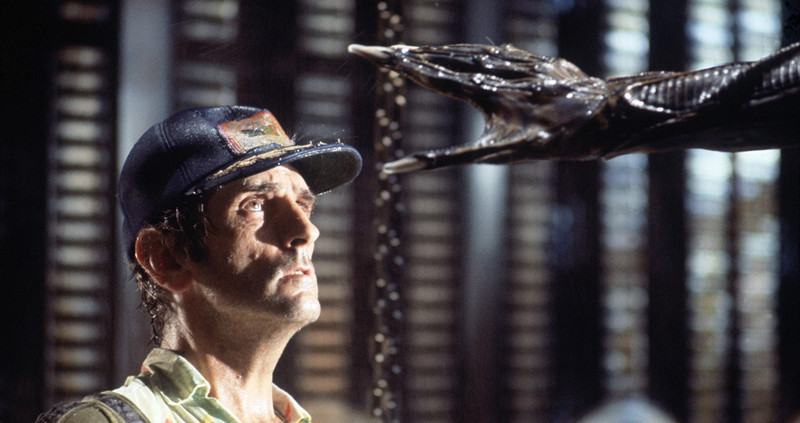
One of the key turning points to the original Alien was when Ash informs the surviving crewmembers that they cannot kill the creature. Yet, at the end of the film, Ripley manages to eject the Alien out of the lifeboat. This becomes a recurring demise for the Aliens that run afoul of Ripley, including the Alien Queen sucked out of the Sulaco, the Alien trapped in the molten lead facility and the Newborn sucked through the window. All of these Xenomorphs ultimately met their doom at the hands of Ripley due to humanity’s one key advantage over the creatures: intelligence.
On a fundamental level, humans are smarter than the Xenomorphs. Disregarding technology and science, many of the humans that encounter that Aliens all acquire superior problem solving abilities and emotional maturity. Yet, many of the humans that confront the Alien/s find themselves against a species that is frequently underestimated.
The crew of the Nostromo and the Colonial Marines are guilty of this more so than any other faction in the Alien saga. Every key beat within both Alien and Aliens is when the Xenomorph does something unpredictable. In the original, the Xenomorph’s ability to turn the tables on Dallas in the air vents and ambush him is a key turning point.
The crew now realise that they are dealing with an intelligent creature. In the sequel, the Marines still underestimate the Aliens after their ambush when the power to Hadley’s Hope is shut off, prompting Pvt. Hudson to state, “What do you mean they cut the power? How could they cut the power man? They’re animals!” The dread felt in the audience the moments the lights switch off, prompting Ripley to whisper, “They cut the power”, was palpable.
Many aspects of the Alien are terrifying: the claws, the tail, the tall frame or its lack of eyes. But what surprises the protagonists (as well as the audience) is its ability to think. This is more than just mindless animal; it is a creature of instinct.
Its ability to adapt to any environment immediately gives it a home field advantage.
6. Acid for blood
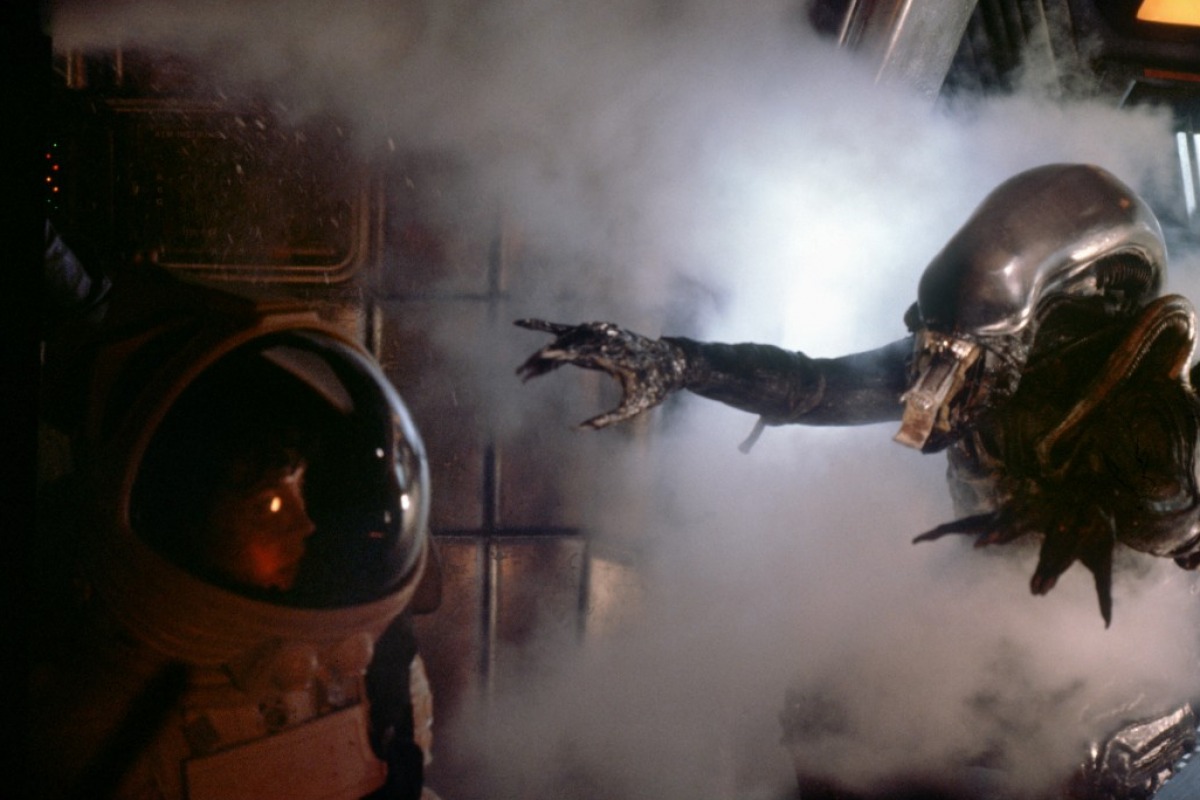
Blood has always been a symbol of death and injury. The boxer with the cut eye, the detective finding blood in the house. Even when the Predator is injured in a battle, leaving a trail of glowing blood, Arnold Schwarzenegger tells his team, “If it bleeds, we can kill it”. The very nature of blood shows vulnerability.
Yet, for a Xenomorph, even its blood has been weaponised. When trying to remove the Facehugger from Kane’s face, a simple incision on the creature’s claw causes a blood spurt that burns through several levels of the ships hull, prompting Parker to state, “It’s got a wonderful defence mechanism. You don’t dare kill it”. Even at its most vulnerable, the Xenomorphs and Facehuggers have one last defence.
While later Xenomorphs possess the ability to spit acid from their mouths, it does not compare to its ability to bleed acid. Ash warned the crewmembers of the Nostromo that they could not kill it. However, clearly this was false as the Xenomorphs are not immune to the Colonial Marines and their high-powered weaponry. However, while it is possible to kill it, the question is whether you dare to.
While the concept of the acid blood, suggested by conceptual artist Ron Cobb, was introduced as a means of explaining why the crew of the Nostromo could not kill it by conventional means, it has taken on a life of its own. For human, blood is used to transport oxygen around the body and remove carbon dioxide.
The exact nature of the acid in the Xenomorph’s body in unexplained. One theory put forward is that due to the Alien’s ability to survive in deep space and without a visible food source, the acid is actually a source of sustenance it, allowing it to adapt to its environment and function without the need of food. Just focusing on the survival of its queens and the expansion of its race.